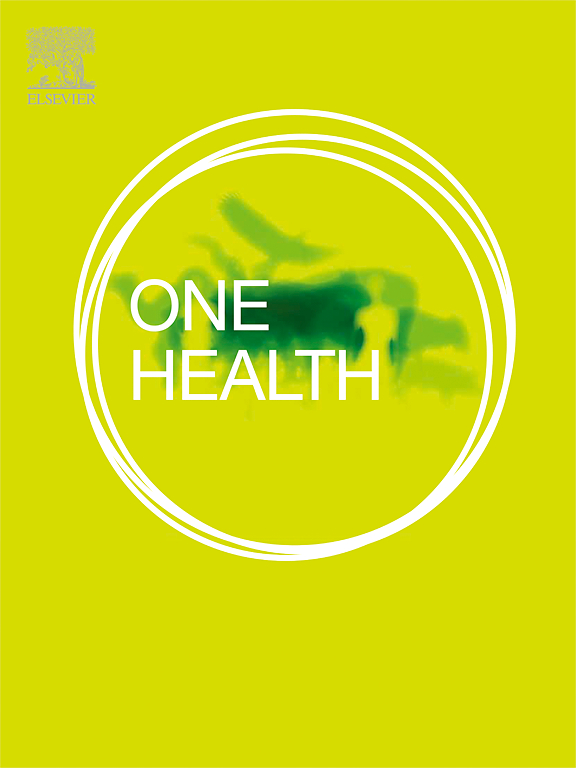为应对马尔堡病毒病暴发而接触野生动物和家畜的行为风险评估,加纳,2022年
IF 4.1
2区 医学
Q1 INFECTIOUS DISEASES
引用次数: 0
摘要
2022年7月,加纳报告了该国首次暴发马尔堡病毒病。爆发的原因尚不清楚。2022年8月,我们进行了一项行为风险评估,调查了与推定指数病例相关的三个农村社区的715名参与者:阿散蒂地区的站点1和加纳西部地区的站点2和站点3。我们的主要目的是描述与野生和家养动物,特别是马尔堡病毒的天然宿主埃及红鼻蝙蝠的接触特征。我们重点研究了两种可能接触ERBs的主要途径:1)吃有咬痕的水果;2)进入有蝙蝠的洞穴或矿井。吃有咬痕的水果在所有遗址中都很常见,但在西部地区的遗址2中最高。较高的教育水平与吃有咬痕的水果呈负相关,而在参与者的家院里有果树则增加了这种接触的几率。3号地点的居民更有可能在洞穴和矿井中接触到蝙蝠。所有地点的参与者还报告说,他们在建筑物内与蝙蝠的接触程度很高;虽然erb通常不在建筑物中栖息,但这存在暴露于其他蝙蝠相关病原体的潜在风险。3号站点的一名参与者报告了过去4个月出现的与MVD一致的症状,这表明可能存在与疫情有关的未被确认的病例。这项研究确定了疫情区域内可能增加接触马尔堡病毒和其他蝙蝠传播病原体风险的行为。这些社区的血清学调查将通过确定未报告的病例以及与其他丝状病毒的接触情况,提供关于马尔堡暴发程度的重要信息。本文章由计算机程序翻译,如有差异,请以英文原文为准。

Behavioral risk assessment of exposure to wild and domestic animals in response to a Marburg virus disease outbreak, Ghana 2022
In July 2022, Ghana reported its first outbreak of Marburg virus disease (MVD). The source of the outbreak was unknown. In August 2022 we conducted a behavioral risk assessment, surveying 715 participants in three rural communities associated with the presumptive index case: Site 1 in Ashanti Region and Sites 2 and 3 in the Western Region of Ghana. Our primary aim was to characterize exposure to wild and domestic animals, specifically Egyptian rousette bats (ERBs), the natural reservoir for Marburg virus. We focused on two primary routes of potential exposure to ERBs: 1) eating fruit bearing bite marks and 2) entering caves or mines where bats were present. Eating fruit bearing bite marks was common across all sites, but highest at Site 2 in the Western Region. Higher levels of education were negatively correlated with eating fruit bearing bite marks, while having fruit trees present on the participant's home compound increased the odds of this exposure. Residents in Site 3 were significantly more likely to be exposed to bats in caves and mines. Participants across all sites also reported high levels of exposure to bats inside buildings; while ERBs do not typically roost in buildings, this presents a potential risk of exposure to other bat-associated pathogens. One participant at Site 3 reported symptoms consistent with MVD in the previous four months, suggesting the possibility of unrecognized cases that may have been associated with the outbreak. This study identified behaviors within the outbreak regions that could increase the risk of exposure to Marburg virus and other bat-borne pathogens. Serological surveys in these communities would provide important information about the extent of the Marburg outbreak by identifying unreported cases, as well as exposure to other filoviruses.
求助全文
通过发布文献求助,成功后即可免费获取论文全文。
去求助
来源期刊

One Health
Medicine-Infectious Diseases
CiteScore
8.10
自引率
4.00%
发文量
95
审稿时长
18 weeks
期刊介绍:
One Health - a Gold Open Access journal.
The mission of One Health is to provide a platform for rapid communication of high quality scientific knowledge on inter- and intra-species pathogen transmission, bringing together leading experts in virology, bacteriology, parasitology, mycology, vectors and vector-borne diseases, tropical health, veterinary sciences, pathology, immunology, food safety, mathematical modelling, epidemiology, public health research and emergency preparedness. As a Gold Open Access journal, a fee is payable on acceptance of the paper. Please see the Guide for Authors for more information.
Submissions to the following categories are welcome:
Virology,
Bacteriology,
Parasitology,
Mycology,
Vectors and vector-borne diseases,
Co-infections and co-morbidities,
Disease spatial surveillance,
Modelling,
Tropical Health,
Discovery,
Ecosystem Health,
Public Health.
 求助内容:
求助内容: 应助结果提醒方式:
应助结果提醒方式:


